نوع مقاله : مقاله پژوهشی
نویسندگان
1 گروه شیمی، دانشگاه پیام نور، صندوق پستی: 4697-19395، تهران- ایران
2 پژوهشکدهی راکتور و ایمنی هستهای، پژوهشگاه علوم و فنون هستهای، صندوق پستی: 1589-81465، اصفهان ـ ایران
چکیده
در این پژوهش کامپوزیتهایی با استفاده از پلیاکریلونیتریل و زئولیت نانوکلینوپتیلولیت تهیه شد. کامپوزیتهای سنتز شده با استفاده از تکنیکهایSEM ،DTG ،FT-IR ،XRF ،XRD مورد شناسایی قرار گرفتند و در نهایت جذب یون زیرکونیم از محلولهای آبی مورد ارزیابی قرار گرفت. در این نانوجاذب نانو زئولیت کلینوپتیلولیت به عنوان جزء فعال برای جذب یون زیرکونیم عمل میکند و پلیاکریلونیتریل نقش متصلکننده را دارد. به علاوه با تغییر اندازه ذرات زئولیت از میکرومتر به مقیاس نانو، علاوه بر افزایش ظرفیت، سینتیک فرایند جذب نیز به شدت افزایش یافت. سرعت جذب توسط نانوکامپوزیت بسیار سریع بوده و بیش از %75 از بیشینه ظرفیت جذب برای زیرکونیم در 5 ساعت اول به دست آمد. تصویر SEM نشان داد که ذرات زئولیت توسط پلیمر PAN به یکدیگر متصل شدهاند. ساختار متخلخل نانوکامپوزیت اجازه نفوذ یونهای موجود در محلول به درون دانههای نانوکامپوزیت و رسیدن به جایگاه تعویض یون را فراهم کرد. اثر پارامترهای pH، دما، زمان و غلظت بر میزان جذب بررسی گردید. زمان تماس و pH بهینه به ترتیب 24 ساعت و 2 بود. بیشینه ظرفیت جذب نانو کامپوزیت 1-mg.g 65/18 به دست آمد. جاذب در شرایط بهینه توانایی حذف %80 از یون زیرکونیم از یک محلول 1-meq.mL 01/0 را دارد. همچنین پارامترهای سینتیکی و ترمودینامیکی استخراج شد. دادههای تجربی با مدل سینتیکی شبه درجه دوم با ضرایب همبستگی بسیار خوبی برازش شدند. بهعلاوه مقادیر تئوری به دست آمده از معادله با مقادیر تجربی توافق خوبی نشان داد. لذا میتوان معادله سینتیکی شبه درجه دوم را مدل مناسبی به منظور تفسیر دادههای تجربی دانست. توافق دادههای تجربی با مدل سینتکی شبه درجه دوم نشان داد مرحله تعیینکننده سرعت، مرحله تعویض یون است. بهعلاوه ثابت سرعت جذب توسط نانوکامپوزیت نسبت به کامپوزیت کلینوپتیلولیت-پلیاکریلونیتریل ماکرومتری مقادیر بیشتری را نشان داد. به عبارتی جذب یون زیرکونیم بر روی نانوکامپوزیت با سرعت قابل ملاحظهای نسبت به کامپوزیت ساخته شده با زئولیت با ابعاد ماکرو انجام شد.ΔH° مثبت و ΔG°منفی نشان داد که فرایند جذب زیرکونیم گرماگیر و خودبهخودی است. دادههای تعادلی با استفاده از مدلهای لانگمویر، فروندلیچ و دوبینین- رادشکویچ ارزیابی شد. براساس مدل ایزوترمی دوبینین-رادشکویچ، جذب یون زیرکونیم از طریق فرایند تعویض یون انجام میشود. مقادیر به دست آمده برای RL در محدودهی 0 تا 1 بود که نشاندهندهی ماهیت مطلوب فرایند جذب زیرکونیم میباشد. مقایسه مقادیر Q0به دست آمده برای جاذبها نشانداد که نانوکامپوزیت دارای بیشترین ظرفیت جذبی برای یون زیرکونیم میباشد. این مقدار بالای Q0 را میتوان با توجه به ابعاد نانومتری کامپوزیت توجیه کرد.
کلیدواژهها
عنوان مقاله [English]
Synthesis of Clinoptilolite-Polyacrylonitrile Nano Composite for removal of zirconium from aqueous solution: Investigation and evaluation of effective parameters on sorption process, kinetic, thermodynamic and adsorption isotherms parameters
نویسندگان [English]
- S. Habibollahi 1
- M. Iravani 2
- A.R. Zarean 1
1 Department of Chemistry, Payame Noor University, P.O. Box: 19395-4697, Tehran, Iran
2 Reactor and Nuclear Safety Research School, Nuclear Science and Technology Research Institute, P.O.Box: 81465-1589, Esfahan - Iran
چکیده [English]
In the present research, composite adsorbents consisting of nano clinoptilolite and polyacrylonitrile (PAN) were prepared. The synthesized composites were characterized by XRD, XRF, FT-IR, DTG and SEM analysis techniques, and finally the adsorption behavior of the composites toward zirconium was investigated. In this nano adsorbent, nano-zeolite clinoptilolite acts as an active component for the absorption of zirconium ions, and polyacrylonitrile plays a bining role. In addition, by changing the size of zeolite particles from micrometer to nanoscale, the adsorption capacity and the kinetic of the adsorption process was increased significantly. The absorption rate by nanocomposites was very rapid and more than 75% of the maximum absorption capacity for zirconium was obtained in the first 5 hours. The SEM image showed that zeolite particles are bonded to each other by a PAN polymer. The porous structure of the nanocomposite allowed permeation of the ions from solution into nanocomposite beads and reaching the ion exchange sites. The effect of pH, initial ion concentration, contact time, and temperature were examined. The optimum contact time and pH were 24 h and 2, respectively. The maximum adsorption capacity of the composite was 18.65 mg.g-1 and the composite was able to remove 80% of Zr+4 from 0.01 meq.mL-1 aqueous solutions. The kinetic and thermodynamic parameters were extracted. The experimental data were well fitted with a pseud-second order kinetic model with good correlation coefficients. In addition, the theoretical values obtained from the equation showed a good agreement with experimental values. Therefore, the pseudo-second order kinetic equation can be considered as a suitable model for interpreting experimental data. The agreement of the experimental data with the Pseudo-second order kinetic model showed that overall rate constant controlled by chemical sorption. In addition, the constant rate of absorption by nanocomposites was higher than that of a clinoptilolite-polyacrylonitrile-macrometric composite. In other words, the absorption of zirconium ion on nanocomposite was significantly higher than that of a zeolite composite with macro dimensions. Positive ΔH° and negative ΔG° were indicative of the endothermic and spontaneous nature of process. The equilibrium data were analyzed by the Langmuir, Freundlich, and Dubinin–Radushkviech isotherm models. D-R isotherm model indicated that ions were uptake through an ion exchange process. The obtained RL values range between 0 to 1, indicating Zr adsorption was favorable. Comparison of Q0 values for adsorbents showed that the nanocomposite has the highest absorption capacity for zirconium ion. This high Q0 value can be explained by the nanoscale size of the composite.
کلیدواژهها [English]
- Clinoptilolite-polyacrylonitrile nano composite
- Zirconium
- Kinetic Parameters
- Thermodynamic Parameters
- Adsorption Isotherm
- Recovery

